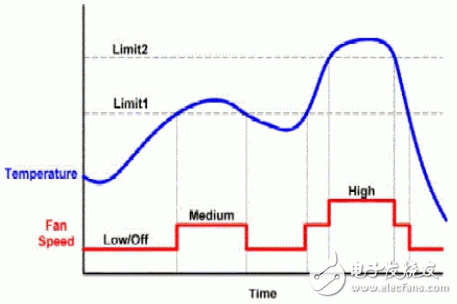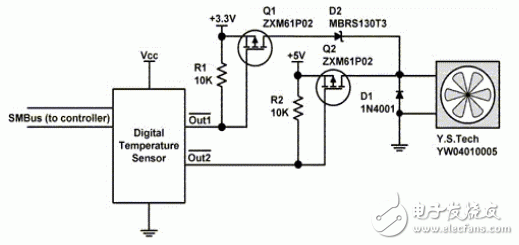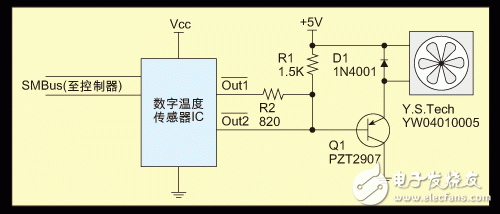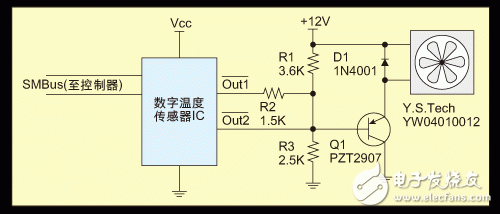In many products, a fan running at low or medium speed is sufficient to dissipate heat, while allowing the highest speed mode to be retained to cope with the worst situation. The circuit described in this article uses linear voltage control and operates the fan at a DC voltage lower than the manufacturer's full rated voltage to reduce the fan speed and reduce noise.
SMBus temperature sensor ICThe commercially available SMBus temperature sensor ICs include sensors that measure the ambient temperature around the IC and devices that support one or more external sensors (that is, some inexpensive triodes connected to diodes).
The SMBu communication interface provides a simple connection to the system microcontroller, and the measurement parameters of the temperature sensor can be configured through a writable register.

Figure 1: The relationship between temperature and fan speed set by the control circuit in this article.
Many SMBus temperature sensors have one or two outputs. When the temperature exceeds a certain limit value (programmed into the IC register), they will work (typically, it goes low). Design engineers can expect a typical sensor accuracy of 1 to 3°C and a resolution as fine as 1/8°C.
The general drive voltages for most DC brushless fans are +5V and +12Vdc. Fans running at full speed can produce annoying noise, so it is important to reduce the fan speed as much as possible. Operating the DC fan under reduced voltage and as the fan ages, the starting voltage of the fan will become a limiting factor, as bearing wear will cause the required starting voltage to increase.
The actual operating voltage range of the fan varies greatly. A fan rated +5V from a certain manufacturer may start with 2Vdc, while another fan of the same size and specification may require 4Vdc to start. When the working voltage of the selected fan is lower than the manufacturer's rated value, it is important to extract the fan characteristics and add some margin, which takes into account the wear and tear and the differences between the fans.

Figure 2: Two transistors realize 5V fan drive.
intelligent control1. Two transistors realize 5V fan drive:
The circuit shown in Figure 2 is useful for fan products powered by +3.3V and +5V. When the temperature is lower than the two limit settings, the open-drain outputs Out1 and Out2 are set high, making R1 and R2 pull up the gates of the P-channel FETs Q1 and Q2, turning them off. When the temperature exceeds the limit value 1 in Figure 1, Out1 becomes low, Q1 is turned on and a voltage of about 3V is applied to the fan through Schottky diode D1. When Out2 goes low, Q2 turns on and applies a voltage of 5V to the fan. D2 ensures that the 5V power supply does not reversely act on the 3.3V power supply through Q1.
This circuit is very efficient, because the base of the triode does not consume current, its function is to switch, and directly connect the fan to the power rail. Choosing Ron<0.75Ω@Vgs=3V P-channel FET can keep the voltage drop and power consumption low. Low power consumption allows the fan to use a small form factor SOT-23 device to achieve a rated current of 400mA@5V.
2. Single transistor to achieve 5V fan drive
.

Figure 3: A single triode realizes 5V fan drive
The circuit shown in Figure 3 uses a PNP transistor to control the three speeds of the fan: stall, medium speed, and high speed. When the temperature is lower than the two limit settings, both Out1 and Out2 become higher. There is no current flowing through the base of Q1, so it is turned off and the fan voltage is 0V.
When the temperature exceeds the limit value 1, Out1 is driven low and the resistor divider R1/R2 sets the voltage at the base of Q1 to 1.8V. Since the base voltage is Vbe, the emitter voltage will be 0.7V higher than Vbe, so that the fan voltage is 2.5V (50% of the full-scale voltage).
When Out2 goes low, it pulls the base of Q1 down to the ground level, and the base current is limited by the maximum absorption capacity of the IC output. The typical value is @Vol=0.4V "" 6-8mA@Vol=0.4V. The base current is limited, and the gain of Q1 should be greater than 100 to ensure a minimum voltage drop and a strong transistor drive capability. The voltage drop between the output device and Q1 limits the maximum fan voltage to 4.1V (82% of the full-scale voltage).
3. A single transistor realizes 12V fan drive
The circuit shown in Figure 4 is slightly different from a single triode circuit and can drive the fan to run at low, medium, and high speeds. This arrangement allows the 12V fan to be controlled by an IC with a maximum output voltage of 5V.

Figure 4: A single triode realizes 12V fan drive.
When both IC outputs are high, the low speed is set by resistors R1 and R3. The R1/R3 voltage divider sets the base voltage of Q1 to 5.0V, which provides the fan with a voltage of approximately 6.3V (52% of the full-scale voltage). When Out1 becomes low, a medium speed can be achieved, and the base voltage is set to 2.5V and the fan voltage to 8.8V (73% of the full-scale voltage) through R2 to absorb current. When Out2 becomes low, the high-speed voltage reaches 11.1V (92% of the full-scale voltage).
Summary of this articleThe SMBus temperature sensor can control the three speeds of the fan, and its system design flexibility is very high and the cost is very low. By using the lower two fan speeds to achieve normal and above-average power consumption operation, the fan speed can be set for silent operation. The maximum speed can be dedicated to the operation under extreme temperature conditions, where the cooling effect takes precedence over the silent operation.
Ring Type Connecting Terminals
Ring Type Connecting Terminals,Terminals,Connecting Terminals
Taixing Longyi Terminals Co.,Ltd. , https://www.lycopperlugs.com